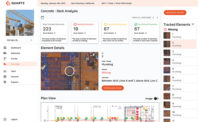ENR 2020 Top 25 Newsmakers
Badri Hiriyur: Developed AI-based Visual Analysis Tool for Facade Inspection

The T2D2 machine-learning algorithm is not intended to replace conventional facade inspections, but it can spot potential damage so repairs can be made before conditions worsen further.
IMAGE COURTESY OF T2D2
The challenges of maintaining facades often come down to a matter of time, cost and effort. Regular inspections are time-consuming, with professional engineers having to review photographs or perform in-person inspections before they can render judgment. But what if some of the process could be automated, allowing for better warning of decaying facades? That was the hypothesis of Badri Hiriyur, director of Thornton Tomasetti’s CORE.AI lab and the inventor of T2D2—or Thornton Tomasetti Damage Detector—a machine-learning-based, image-analysis algorithm that can identify and categorize damage to building facades from photo and video alone.
What began as an entrant in an internal competition at Thornton Tomasetti has matured into a fully spun-off start-up, with T2D2 now being considered for use by some of the largest building and asset owners in the U.S. to augment their inspections. Hiriyur shepherded the project from its earliest stages, where he and others on his team manually marked up building inspection photos in order to teach the visual-inspection algorithm what to look for, one crack at a time.
In its current state, T2D2 can crunch through thousands of images captured by humans or drones and identify signs of possible damage on a variety of facade materials. Highlighting each potential problem, the algorithm provides a much-needed first pass for inspecting photos and videos that a trained engineer would otherwise spend dozens of hours poring over.
Trained on the vast digital stores of facade inspection data in Thornton Tomasetti’s archives, T2D2 has grown significantly in capability from its initial state, but it is not intended to replace a trained engineer’s eye. Rather, it allows the engineer to focus in on possible problem areas, and when paired with drone flights, provides a nearly autonomous workflow for checking the status of building facades. “Engineers are still going to stamp and seal a report,” says Raymond Daddazio, Thornton Tomasetti senior consultant and the firm’s former president. “But ultimately we will have a better and less costly way to maintain our buildings.”
Hiriyur’s T2D2 system was one of four winners of the New York City Dept. of Buildings’ 2020 Hack the Building Code competition and is being explored by the agency as a way to augment its traditional hands-on facade inspections. New York City currently requires facade inspections every five years for any building over six stories, but T2D2 could allow for more frequent, semi-automated inspections that would catch problems earlier.
Improving facade maintenance has become a priority for the NYC DOB in the wake of a fatal accident near Times Square on Dec. 18, 2019. Architect Erica Tishman died when masonry rubble fell off a building facade that had previously been cited by DOB. “When we spoke to the Dept. of Buildings early on [in 2020], that was their focus,” says Daddazio. “How do you make sure no one is killed by a falling facade, and make sure sidewalk sheds don’t stay up forever? Suppose you can fly a drone once a year after every winter and identify what needs to be dealt with?”
While the initial response has been strong, Hiriyur remains realistic about the amount of work ahead of him to get T2D2 into more hands. “So far we have been successful, but we still have a long way to go,” he tells ENR. His new start-up, also called T2D2, is now in conversation with cities, school districts and even National Parks across the country about potential uses for the technology. “We’re moving on from pilot projects to paid projects, so that’s great.” The start-up plans to seek Series A funding later this year.




